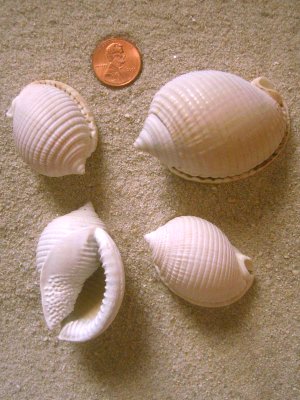
Scotch Bonnet
Phalium granulatum Born, 1778

Scotch Bonnet
Phalium granulatum Born, 1778
North Carolina was the first state to designate an official state seashell. The shell chosen was the Scotch Bonnet shell, in honor of the many Scottish settlers who came to North Carolina.
This gastropod shell may reach a height of 3-4 inches. It belongs to the helmet snail family called Cassidae, of which there are approximately 80 living species. The Scotch Bonnet lives in shallow water on sand bottoms. Like other members of its family, it resides in warmer seas.
The shell is somewhat egg-shaped with a short, sharp spire. It is white or peach with uniform, squarish, brown-orange markings (if it hasn't been bleached by the sun). The shell has about 5 whorls and a large aperture. The outer lip of the aperture is very thick and toothed. The enlarged inner lip has numerous pimple-like bumps. The shell has a broad, glassy area beside the aperture. This area is called the parietal shield.
The outer surface of the shell normally has incised transverse lines and perhaps axial riblets, though the polished Scotch Bonnet P. cicatricosum lacks this faintly beaded appearance.
Helmet shells are thick, and cameos are cut from some species. On certain South Pacific Islands natives use the shells for cooking utensils, for bailing canoes, or as trumpets.
The Scotch Bonnet has a fan-shaped aperculum used to close its aperture. The female lays her horny egg capsules in a several-inches-tall egg column. She sits on the elevating tower as she lays the eggs. The hatchling, called a veliger, is a free-swimming creature for several weeks. The adult has a large foot; a rolled, tube-shaped siphon; slender tentacles, at the base of which are eyes; and a retractable proboscis.
Scotch Bonnets like to eat sea biscuits, sand dollars, and sea urchins. When feeding they dissolve the calcareous tests (shells) of the echinderms by secreting a substance containing sulfuric acid. Once the test has softened, they quickly cut a hole to expose the edible contents.
Scotch Bonnet shells live offshore from North Carolina to Texas and Brazil, and around Bermuda. After a storm or a long period of strong wind blowing toward shore, you are more likely to find these lovely mollusk shells.
Sometimes the Scotch Bonnet is called Scotch Helmet.